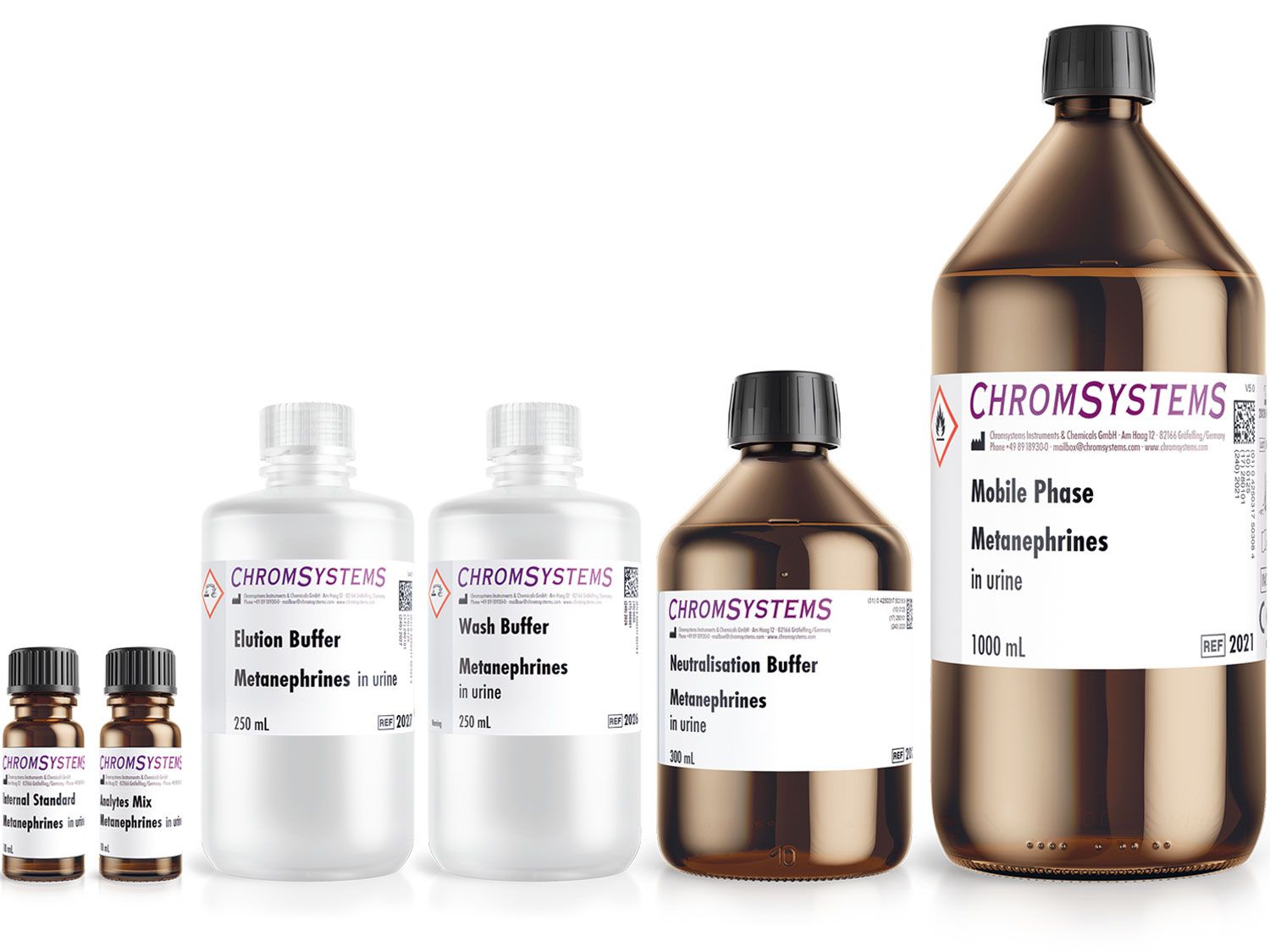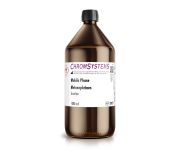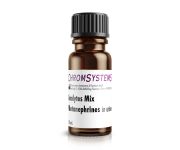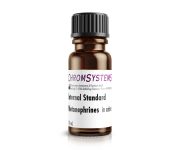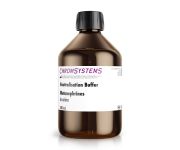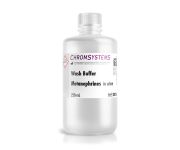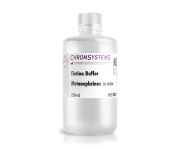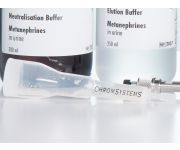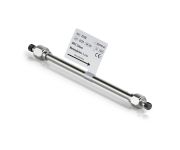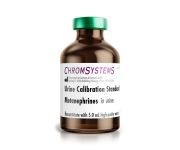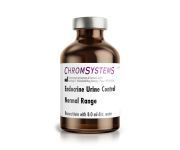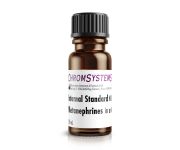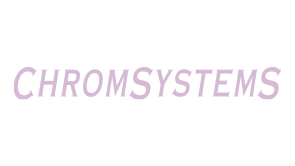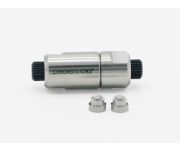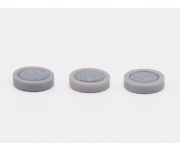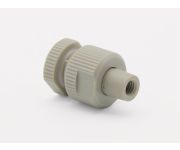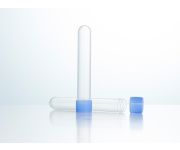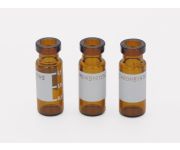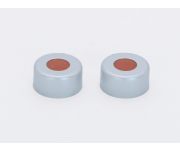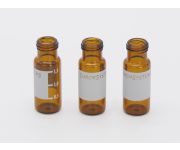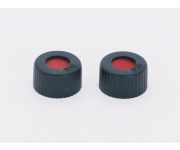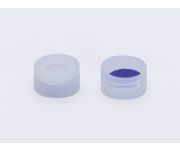Metanephrines in Urine - HPLC Reagent Kit
Only 1 sample clean up column per sample / calibrator / control required
Suitable for semi-automated sample preparation
Assay validated according to IVDR (=> Declaration of Conformity)
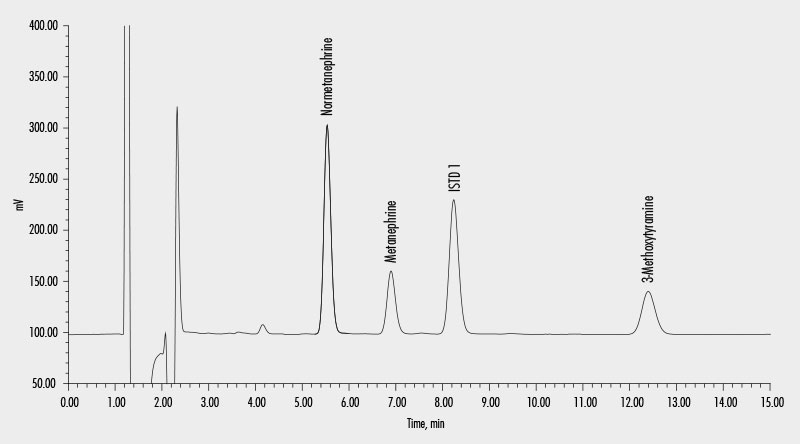

Total 3-Methoxytyramine
Total Metanephrine
Total Normetanephrine
Clinical relevance
This assay allows the simultaneous quantitative determination of total (sum of free and conjugated metabolites) metanephrine, normetanephrine and 3-methoxytyramine in human urine samples.
It is intended to be used for patients in whom the urinary levels of total normetanephrine, total metanephrine and total 3-methoxytyramine are of clinical importance, primarily as an aid to diagnosis and monitoring of suspected pheochromocytoma and paraganglioma.
Furthermore, it is intended for patients in whom the urinary levels of total normetanephrine and total 3-methoxytyramine are of clinical importance, as an aid to diagnosis and monitoring of suspected neuroblastoma.
Assay characteristics
Sample preparation is carried out manually or semi-automated on ASPEC® (simple liquid handling system), and analytic separation is done via high performance liquid chromatography with electrochemical detection (HPLC-ECD). The use of a specific internal standard ensures high precision and reliability in quantitation of the analytes.
The assays 2020-C and 6000-C are available as alternative methods that allow the combined determination of catecholamines and metanephrine with one column.
Detailed performance evaluation data can be found in Appendices II and III of the instruction manual.
Two types of kits available
Basic Kit
• Only sample preparation reagents and sample clean up columns included
• No excess quantities of mobile phase and calibrators
|
2020-BK Basic Kit |
|
| 2024 | Internal Standard, 10 mL (1x) |
| 2025 | Neutralisation Buffer, 300 mL (2x) |
| 2026 | Wash Buffer, 250 mL (2x) |
| 2027 | Elution Buffer, 250 mL (2x) |
| 2028 | Sample Clean Up Columns, 100 pcs. (1x) |
Reagent Kit
• Mobile phase and calibrator included
|
2020-B Reagent Kit |
|
| 2024 | Internal Standard, 10 mL (1x) |
| 2025 | Neutralisation Buffer, 300 mL (2x) |
| 2026 | Wash Buffer, 250 mL (2x) |
| 2027 | Elution Buffer, 250 mL (2x) |
| 2028 | Sample Clean Up Columns, 100 pcs. (1x) |
| 2021 | Mobile Phase, 1000 mL (1x) |
| 2033 | Analytes Mix, 10 mL (1x) |
| Method of Analysis | HPLC |
|---|---|
| Number of Tests | 100 |
| Please note | The information listed here, including the sample preparation, is not sufficient for using the product. Please read the information provided in the instruction manual, which includes detailed information on limitations associated with the use of the product in line with its intended purpose. Detailed performance evaluation data can be found in Appendices II and III of the instruction manual. |
| Lower and Upper Limit of Quantitation | Total Normetanephrine: 4.5 µg/L – 3000 µg/L |
| Specimen | 24-hour urine. Alternatively spot urine may also be used. In this case, results must be related to creatinine. |
| Sample Preparation | The information on the manual sample preparation presented here is not sufficient for use in the laboratory. For a detailed step by step description, please refer to the instruction manual. Acidic hydrolysis Neutralisation Extraction Continued sample preparation prior to injection
For the semi-automated sample preparation with the Gilson® ASPEC®, please refer to the instruction manual. |
| Run Time | 15 min (Internal Standard 2024) --- 20 min (Internal Standard High Resolution 2044/HR) |
| Injection Volume | 20 µL (manual sample preparation) |
| Flow Rate | 1.0 mL/min |
| Column Temperature | +20 to +25 °C |
| Potential | approx. +780 mV to +840 mV |
| Additional Info | For the Chromsystems HPLC analysis of metanephrines in urine any isocratic HPLC system with electrochemical detector is suitable. |
| Parameters | Total 3-Methoxytyramine, Total Metanephrine, Total Normetanephrine |
Metanephrines in Urine - HPLC Reagent Kit (2020-B)
For 100 tests
| Order No. | Reagent Kit components (Quantities in kit) |
| 2021 | Mobile Phase, 1000 mL (1x) |
| 2033 | Analytes Mix, 10 mL (1x) |
| 2024 | Internal Standard, 10 mL (1x) |
| 2025 | Neutralisation Buffer, 300 mL (2x) |
| 2026 | Wash Buffer, 250 mL (2x) |
| 2027 | Elution Buffer, 250 mL (2x) |
| 2028 | Sample Clean Up Columns, 100 pcs. (1x) |
| Order No. | Required components (not included in the Reagent Kit) |
| 2120 | HPLC Column, equilibrated, with test chromatogram, 1 pc. |
| 2009 | Urine Calibration Standard, 5 x 5.0 mL (lyoph.) |
| 0040 | Endocrine Urine Control, Level I, 10 x 8.0 mL (lyoph.) |
| 0050 | Endocrine Urine Control, Level II, 10 x 8.0 mL (lyoph.) |
| 2044/HR | Internal Standard, High Resolution, 10 mL |
| Order No. | Lab equipment |
| 18010 | Precolumn Cartridge 4/10, 1 pc. |
| 18001 | Precolumn Cartridge Holder 4/10, 1 pc. |
| 15009 | PEEK-encased Prefilter, 5 µm, 5 pcs. |
| 15010 | PEEK Prefilter Housing, 1 pc. |
| 2010 | Hydrolysis Tubes with Screw Caps, 50 pcs. |
| J0404 | Autosampler Vials, amber glass, 100 pcs. |
| J0406 | Crimp Caps with Natural Rubber/PTFE septa, 100 pcs. |
| J0601 | Autosampler Vials, screw neck, amber glass, 1.5 ml, 100 pcs. |
| J0504 | PP Screw-on caps, rubber/PTFE septa, 9 mm, 100 pcs. |
| J0410 | PP Screw-on Caps, pierceable silicone/PTFE septa, 1.0 mm, 100 pcs. |


Total 3-Methoxytyramine
Total Metanephrine
Total Normetanephrine
Clinical relevance
This assay allows the simultaneous quantitative determination of total (sum of free and conjugated metabolites) metanephrine, normetanephrine and 3-methoxytyramine in human urine samples.
It is intended to be used for patients in whom the urinary levels of total normetanephrine, total metanephrine and total 3-methoxytyramine are of clinical importance, primarily as an aid to diagnosis and monitoring of suspected pheochromocytoma and paraganglioma.
Furthermore, it is intended for patients in whom the urinary levels of total normetanephrine and total 3-methoxytyramine are of clinical importance, as an aid to diagnosis and monitoring of suspected neuroblastoma.
Assay characteristics
Sample preparation is carried out manually or semi-automated on ASPEC® (simple liquid handling system), and analytic separation is done via high performance liquid chromatography with electrochemical detection (HPLC-ECD). The use of a specific internal standard ensures high precision and reliability in quantitation of the analytes.
The assays 2020-C and 6000-C are available as alternative methods that allow the combined determination of catecholamines and metanephrine with one column.
Detailed performance evaluation data can be found in Appendices II and III of the instruction manual.
Two types of kits available
Basic Kit
• Only sample preparation reagents and sample clean up columns included
• No excess quantities of mobile phase and calibrators
|
2020-BK Basic Kit |
|
| 2024 | Internal Standard, 10 mL (1x) |
| 2025 | Neutralisation Buffer, 300 mL (2x) |
| 2026 | Wash Buffer, 250 mL (2x) |
| 2027 | Elution Buffer, 250 mL (2x) |
| 2028 | Sample Clean Up Columns, 100 pcs. (1x) |
Reagent Kit
• Mobile phase and calibrator included
|
2020-B Reagent Kit |
|
| 2024 | Internal Standard, 10 mL (1x) |
| 2025 | Neutralisation Buffer, 300 mL (2x) |
| 2026 | Wash Buffer, 250 mL (2x) |
| 2027 | Elution Buffer, 250 mL (2x) |
| 2028 | Sample Clean Up Columns, 100 pcs. (1x) |
| 2021 | Mobile Phase, 1000 mL (1x) |
| 2033 | Analytes Mix, 10 mL (1x) |
| Method of Analysis | HPLC |
|---|---|
| Number of Tests | 100 |
| Please note | The information listed here, including the sample preparation, is not sufficient for using the product. Please read the information provided in the instruction manual, which includes detailed information on limitations associated with the use of the product in line with its intended purpose. Detailed performance evaluation data can be found in Appendices II and III of the instruction manual. |
| Lower and Upper Limit of Quantitation | Total Normetanephrine: 4.5 µg/L – 3000 µg/L |
| Specimen | 24-hour urine. Alternatively spot urine may also be used. In this case, results must be related to creatinine. |
| Sample Preparation | The information on the manual sample preparation presented here is not sufficient for use in the laboratory. For a detailed step by step description, please refer to the instruction manual. Acidic hydrolysis Neutralisation Extraction Continued sample preparation prior to injection
For the semi-automated sample preparation with the Gilson® ASPEC®, please refer to the instruction manual. |
| Run Time | 15 min (Internal Standard 2024) --- 20 min (Internal Standard High Resolution 2044/HR) |
| Injection Volume | 20 µL (manual sample preparation) |
| Flow Rate | 1.0 mL/min |
| Column Temperature | +20 to +25 °C |
| Potential | approx. +780 mV to +840 mV |
| Additional Info | For the Chromsystems HPLC analysis of metanephrines in urine any isocratic HPLC system with electrochemical detector is suitable. |
| Parameters | Total 3-Methoxytyramine, Total Metanephrine, Total Normetanephrine |
Metanephrines in Urine - HPLC Reagent Kit (2020-B)
For 100 tests
| Order No. | Reagent Kit components (Quantities in kit) |
| 2021 | Mobile Phase, 1000 mL (1x) |
| 2033 | Analytes Mix, 10 mL (1x) |
| 2024 | Internal Standard, 10 mL (1x) |
| 2025 | Neutralisation Buffer, 300 mL (2x) |
| 2026 | Wash Buffer, 250 mL (2x) |
| 2027 | Elution Buffer, 250 mL (2x) |
| 2028 | Sample Clean Up Columns, 100 pcs. (1x) |
| Order No. | Required components (not included in the Reagent Kit) |
| 2120 | HPLC Column, equilibrated, with test chromatogram, 1 pc. |
| 2009 | Urine Calibration Standard, 5 x 5.0 mL (lyoph.) |
| 0040 | Endocrine Urine Control, Level I, 10 x 8.0 mL (lyoph.) |
| 0050 | Endocrine Urine Control, Level II, 10 x 8.0 mL (lyoph.) |
| 2044/HR | Internal Standard, High Resolution, 10 mL |
| Order No. | Lab equipment |
| 18010 | Precolumn Cartridge 4/10, 1 pc. |
| 18001 | Precolumn Cartridge Holder 4/10, 1 pc. |
| 15009 | PEEK-encased Prefilter, 5 µm, 5 pcs. |
| 15010 | PEEK Prefilter Housing, 1 pc. |
| 2010 | Hydrolysis Tubes with Screw Caps, 50 pcs. |
| J0404 | Autosampler Vials, amber glass, 100 pcs. |
| J0406 | Crimp Caps with Natural Rubber/PTFE septa, 100 pcs. |
| J0601 | Autosampler Vials, screw neck, amber glass, 1.5 ml, 100 pcs. |
| J0504 | PP Screw-on caps, rubber/PTFE septa, 9 mm, 100 pcs. |
| J0410 | PP Screw-on Caps, pierceable silicone/PTFE septa, 1.0 mm, 100 pcs. |

